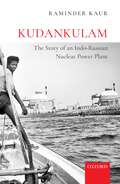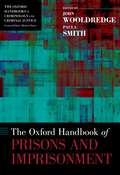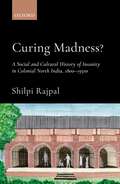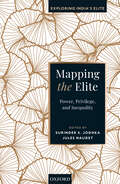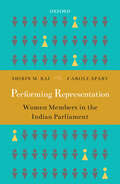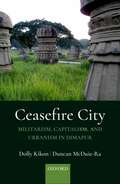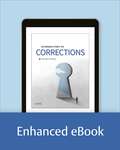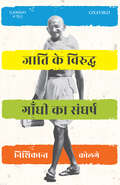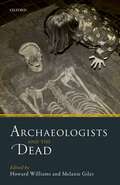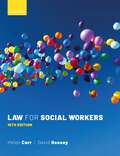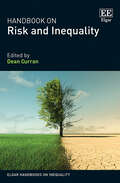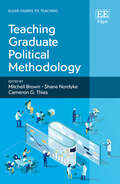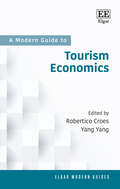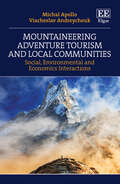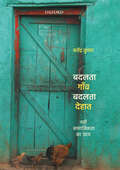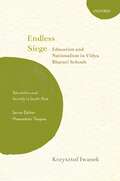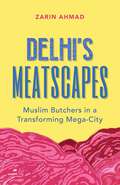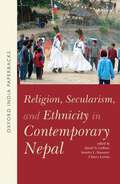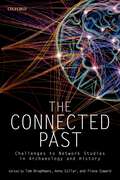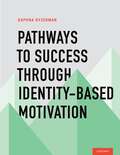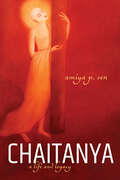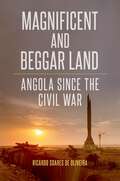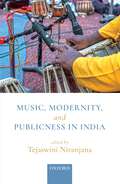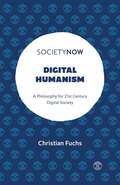- Table View
- List View
Kudankulam: The Story of an Indo-Russian Nuclear Power Plant
by Raminder KaurSince the 1980s, the Kudankulam Nuclear Power Plant in the south Indian state of Tamil Nadu has faced multiple forms of resistance. Women and men from different walks of life—fishers, farmers, environmentalists, activists, writers, scholars, teachers, journalists, doctors, and lawyers among many others—have come together to combat the deadly radioactive repercussions and repression that come with the development of a high-security nuclear installation. Drawing upon their experiences, this historical and ethnographic study accounts for the anti-nuclear campaign’s part in ‘right-to-lives’ movements while engaging with the (re)production of knowledge and ignorance in the understanding of radiation, and efforts to create an evidence base in response to the otherwise unavailable or insufficient data on the environment and public health in India. Tracing the grassroots struggle for ‘energy justice’ off- and on-line, the author looks into the larger questions of development, democracy, and nationalism. These have marked not just parts of India identified for large-scale constructions, but also other regions of the world where state functionaries have much to gain from corporate collaborations at the cost of local residents who lose their livelihoods, and are forcibly displaced, persecuted, or even killed in order to execute governmental designs in the name of the nation.
The Oxford Handbook of Prisons and Imprisonment (Oxford Handbooks)
Research on prisons prior to the prison boom of the 1980s and 1990s focused mainly on inmate subcultures, inmate rights, and sociological interpretations of inmate and guard adaptations to their environment, with qualitative studies and ethnographic methods the norm. In recent years, research has expanded considerably to issues related to inmates' mental health, suicide, managing special types of offenders, risk assessment, and evidence-based treatment programs. The Oxford Handbook of Prisons and Imprisonment provides the only single source that bridges social scientific and behavioral perspectives, providing graduate students with a more comprehensive understanding of the topic, academics with a body of knowledge that will more effectively inform their own research, and practitioners with an overview of evidence-based best practices. Across thirty chapters, leading contributors offer new ideas, critical treatments of substantive topics with theoretical and policy implications, and comprehensive literature reviews that reflect cumulative knowledge on what works and what doesn't. The Handbook covers critical topics in the field, some of which include recent trends in imprisonment, prison gangs, inmate victimization, the use and impact of restrictive housing, unique problems faced by women in prison, special offender populations, risk assessment and treatment effectiveness, prisoner re-entry, and privatization. The Oxford Handbook of Prisons and Imprisonment offers a rich source of information on the current state of institutional corrections around the world, on issues facing both inmates and prison staff, and on how those issues may impede or facilitate the various goals of incarceration.
Curing Madness?: A Social and Cultural History of Insanity in Colonial North India, 1800–1950s
by Shilpi RajpalCuring Madness? focusses on the institutional and non-institutional histories of madness in colonial north India. It proves that 'madness' and its 'cure' are shifting categories which assumed new meanings and significance as knowledge travelled across cultural, medical, national, and regional boundaries. The book examines governmental policies, legal processes, diagnosis and treatment, and individual case histories by looking closely at asylums in Agra, Benaras, Bareilly, Lucknow, Delhi, and Lahore. Rajpal highlights that only a few mentally ill ended up in asylums; most people suffering from insanity were cared for by their families and local vaidyas, ojhas, and pundits. These practitioners of traditional medicine had to reinvent themselves to retain their relevance as Western medical knowledge was widely disseminated in colonial India. Evidence of this is found in the Hindi medical advice literature of the era. Taking these into account Shilpi Rajpal moves beyond asylum-centric histories to examine extensive archival materials gathered from various repositories.
Mapping the Elite: Power, Privilege, and Inequality
by Surinder S. Jodhka Jules NaudetIndia is being widely seen as an emerging economic and political power on the global scene. Despite having the largest population of chronically poor in the world today, it is home to a sizeable number of thriving rich and flourishing middle classes. They are reshaping the country’s popular image and its self-imagination. Equally important are its political dynamics. With increasing participation of erstwhile-marginalized sections in the electoral process, the social profile of India’s political elite has been changing, making way for those coming from the middle and lower strata of the traditional social order, thus broadening the social base of political power. Mapping the Elite seeks to expand the understanding of processes of formations and transformations of the Indian elite. The contributors explore the emergent elite spaces, the new idioms of power and inequality, the diverse strategies in which symbolic boundaries of privilege are traced in everyday lives, as well as the class mobilities in an age of proclaimed meritocracy. They do so by using the sociological frames of caste, class, gender, community, and their intersections. The ''Exploring India’s Elite' series provides a platform to scholars working on elite dynamics in India. It seeks to enable an understanding of the nuances of inequality, power, and other emerging social structures.
Performing Representation: Women Members in the Indian Parliament
by Shirin M. Rai Carole SparySeven decades after India’s independence women members occupy 1 in 10 seats in the Lok Sabha, the lower house of the Indian Parliament. In analysing women’s limited presence in the Indian Parliament, Performing Representation breaks new ground in scholarship on gender and politics. It explores the possibilities and limits of parliamentary democracy and the participation of women in its institutional performances. This book offers new insights into the gendered nature of the performance, aesthetics, and norms of parliamentary life through an examination of electoral data, legislative debates, and life stories of women MPs. The authors avoid both the framing of women MPs either simply as challengers of masculinized institutional politics or only as docile actors in a gendered institution. Making a strong case for taking parliamentary politics seriously in these times of populism, the book raises critical questions about the politics of difference, claim-making, representation, and intersectionality and addresses these as part of global feminist debates on the importance of the women’s representation in political institutions.
Ceasefire City: Militarism, Capitalism, and Urbanism in Dimapur
by Dolly Kikon Duncan McDuie-RaFor a city in India's northeast that has been embroiled in the everyday militarization and violence of Asia's longest-running separatist conflict, Dimapur remains 'off the map'. With no 'glorious' past or arenas where events of consequence to mainstream India have taken place, Dimapur's essence is experienced in oral histories of events, visual archives of the everyday life, lived reality of military occupation, and anxieties produced in making urban space out of tribal space. Ceasefire City aims to capture the dynamics of Dimapur by bringing together the fragmented sensibilities granted and contested in particular spaces in the city and the embodied experiences of the city by its residents. The first part of the book talks about military presence, capitalist growth, and urban expansion in Dimapur through an analysis of its spatial politics, and the second part, through collaborative ethnographic exercises, focuses on the relationship between the lived realities and the meanings that are forged around the city.
Introduction to Corrections
by Joycelyn PollockPollock's introductory text intends to present corrections in a new way for instructors who desire to prepare students in a problem-based, data-driven, media-savvy approach to achieve competency as correctional professionals or knowledgeable consumers of corrections' news. Each chapter will utilize current news and governmental reports along with academic studies, and have a discussion of race/ethnicity when appropriate.
Jaati ke Viruddh Gandhi ka Sangharsh
by Nishikant KolgeIn 1909, while still in South Africa, Gandhi publicly decried the caste system for its inequalities. Shortly after his return to India though, he spoke of the generally beneficial aspects of caste. Gandhi's writings on caste reflect contradictory views and his critics accuse him of neglecting the unequal socio-economic structure that relegated Dalits to the bottom of the caste hierarchy. So, did Gandhi endorse the fourfold division of the Indian society or was he truly against caste? In this book, Nishikant Kolge investigates the entire range of what Gandhi said or wrote about caste divisions over a period of more than three decades: from his return to India in 1915 to his death in 1948. Interestingly, Kolge also maps Gandhi's own statements that undermined his stance against the caste system. These writings uncover the 'strategist Gandhi' who understood that social transformation had to be a slow process for the conservative but powerful section of Hindus who were not yet ready for radical reforms. Seven decades after it attained freedom from colonial powers, caste continues to influence the socio-political dynamics of India, and Gandhi against caste—the battle is not over yet.
Archaeologists and the Dead: Mortuary Archaeology in Contemporary Society
This volume addresses the relationship between archaeologists and the dead, through the many dimensions of their relationships: in the field (through practical and legal issues); in the lab (through their analysis and interpretation); and in their written, visual and exhibitionary practice - disseminated to a variety of academic and public audiences. Written from a variety of perspectives, its authors address the experience, effect, ethical considerations, and cultural politics of working with mortuary archaeology. Whilst some papers reflect institutional or organisational approaches, others are more personal in their view: creating exciting and frank insights into contemporary issues which have hitherto often remained 'unspoken' amongst the discipline. Reframing funerary archaeologists as 'death-workers' of a kind, the contributors reflect on their own experience to provide both guidance and inspiration to future practitioners, arguing strongly that we have a central role to play in engaging the public with themes of mortality and commemoration, through the lens of the past. Spurred by the recent debates in the UK, papers from Scandinavia, Austria, Italy, the US, and the mid-Atlantic, frame these issues within a much wider international context which highlights the importance of cultural and historical context in which this work takes place.
Law for Social Workers
by Helen Carr David GooseyLaw for Social Workers has been supporting social work students and professionals for over 25 years. Written by an expert team with practical experience, this book provides the perfect combination of legal explanation and practical insight and is the ideal text to see students through their course and career. This edition continues to provide an accurate, jargon-free account of the law social workers need to know, with helpful diagrams and case studies included throughout to explain areas of difficulty and ensure understanding for students and professionals at all levels. It also includes the Social Worker's Toolkit, which offers practical advice on topics such as going to court, preparing evidence, and writing reports, providing the ideal support while on placement or in the workplace. Digital formats and resources The sixteenth edition is available for students and institutions to purchase in a variety of formats, and is supported by online resources. The e-book offers a mobile experience and convenient access along with functionality tools, navigation features and links that offer extra learning support: www.oxfordtextbooks.co.uk/ebooks This edition's online resources include: -Video tutorials on a range of practical topics -Multiple choice questions for students to test their knowledge -Guidance on answering the exercises from the book -Further reading suggestions -Glossary and flashcards of legal jargon - PowerPoint slides with accompanying notes for lecturers
Handbook on Risk and Inequality (Elgar Handbooks on Inequality)
This unique Handbook charts shifts in the relationship between risks and inequalities over the last few decades, analysing how inequalities shape risk and how risks condition and intensify inequalities. Expert contributors examine the impacts of environmental, financial, social, urban, economic, and digital risks on inequalities, at both national and global levels.Identifying how the rise of novel risk formations is associated with changes in contemporary political economies, chapters explore new areas of research including the new urban crisis, the gendered impacts of precarious labour and social inequality in relation to agro-biotechnology. Contributing to an underdeveloped area of research, the Handbook breaks new ground to explore how tackling important issues via the prism of risk and inequality can provide novel insights, that solely focusing on only one or the other of these issues cannot.This Handbook will be critical reading for scholars and students of sociology, sociological theory, geography and political science. Its exploration of shifts in contemporary socially produced risks will also be beneficial for practitioners, economists and policy makers in these areas.
Teaching Graduate Political Methodology (Elgar Guides to Teaching)
Providing expert advice from established scholars in the field of political science, this engaging companion book to Teaching Undergraduate Political Methodology imparts informative guidance on teaching research methods across the graduate curriculum. Written in a concise yet comprehensive style, it illustrates practical and conceptual advice, alongside more detailed chapters focussing on the different aspects of teaching political methodology. Each chapter draws on practised teaching methods covering the what, how and when for teaching political methodology with an in-depth look at systematic research methods. The book is split into four distinct sections for graduate research methods education: the approach, the foundations of research design, quantitative analysis and qualitative analysis. Chapters offer evidence-based advice grounded in the science of teaching and learning (SoTL) literature from experienced, award-winning and highly recognized instructors of political methodology. Teaching Graduate Political Methodology will be required reading for faculty wanting to establish excellent methods for challenging subjects within the fields of political science, public administration and public policies. It will also serve as a useful resource for instructors wishing to gain greater student engagement with their courses by utilising different methods.
A Modern Guide to Tourism Economics (Elgar Modern Guides)
This Modern Guide captures the evolution of foundational tenets, theories, frameworks and models that buttressed tourism economics into an evolving discipline, shining light on both new and old approaches. It systematically examines current and future trends and issues related to new economic perspectives, consolidating the notion of tourism economics as a discipline.Chapters delve into the theoretical underpinnings of specific topics within the field, providing a range of examples of how to leverage economic theories to better understand, manage, and promote tourism activities to different stakeholders. Offering a kaleidoscope of economic perspectives, the Modern Guide looks at tourism economics from trade theory, choice theory, behavioural economics, public choice, institutional economics, environmental economics, developmental economics, cultural economics and more, with each chapter ending with insights into future research and directions.Written in an accessible style, this will be an invigorating read for hospitality and tourism management scholars, as well as tourism geographies, tourism marketing and sustainable tourism students. It will also be a useful tool for tourism economists and applied economists looking for a wide range of perspectives on the topic.
Mountaineering Adventure Tourism and Local Communities: Social, Environmental and Economics Interactions
by Michal Apollo Viacheslav AndreychoukThis timely book explores how hiking, trekking and climbing mountains, increasingly popular leisure activities, can stimulate change and create opportunities for sustainable development. Using empirical evidence from interviews held in the Himalayas combined with a theoretical grounding, it focuses on the socio-economic and environmental issues of the impact of mountaineering adventure tourism on local communities.Chapters highlight the progressive stages of the host–guest interactions between local communities and tourists, moving from initial, indirect and final tourism development, and the unique sociocultural phenomena these create. The book examines how, with a planned and systematic approach, mountaineering can be a key factor in promoting an overall improvement in local people’s quality of life through initiatives in economic development and environmental conservation. It offers a look towards the future to create sustainable tourism development in mountain regions.This is an invigorating read for adventure tourism and human geography scholars, particularly with the blend of theory and first-hand studies of local impacts of mountain tourism. It will also be an interesting read for industry representatives, policy makers and professionals in the field.
Badalte Gaon, Badalta Dehat: Nayi Samajikta ka Uday
by Satendra KumarEveryday life in contemporary rural India is characterized by an increased sense of mobility, inequality, and uncertainty. Ordinary villagers often find themselves caught between the promises and failures of democracy and development. This ethnographic study of the village of Khanpur (in Uttar Pradesh, north India) is an attempt to grasp everyday life in rural India. Drawing on descriptions of village life, interspersed with theoretical analyses, the author examines how ordinary people construct their own sense of their lives and their futures in everyday activities: working on farms, attending college, searching for non-farm employment, celebrating religious rituals, and dealing with local elections and democracy. The villagers confront growing economic and moral uncertainty; they creatively harmonize public discourse and local practice; and sometimes they resolve incoherence and unease through the use of irony. In so doing, they perform everyday village and caste ethics and re-create transient political, economic, and moral communities at a time of massive social dislocation. Satendra Kumar in this lucid book shows, in no uncertain terms, that villages in Uttar Pradesh and elsewhere have been and continue to be vibrant grounds for the production of culture, sociality, hope, politics, and persons. He also addresses anthropology's forfeiture of the village as a subject of study in an era of globalization.
Endless Siege: Education and Nationalism in Vidya Bharati Schools
by Krzysztof IwanekThis is an ethnographic study of the Vidya Bharati chain of schools in India which are run by a Hindu nationalist organization called the Rashtriya Swayamsevak Sangh (RSS). The first study of its kind, this volume is an important narrative on the role and impact of textbooks in modern India. Despite having limited resources (they are run on a tight budget) and being based on a radical ideology that derives from a 'Hindu' nationalist agenda, the Vidya Bharati schools have achieved considerable success in the free market of private education and have grown to over 12,000 schools within 40 years. They are an important example of the interlinkage between ideology and nationalism in contemporary India. The author analyses school structure, curriculum, teaching quality, institutional goals, and ideology in an effort to identify reasons behind Vidya Bharati's success and to show through his field research that a combined strategy of pragmatism blended with ideology has allowed the schools to become highly sought-after. This analysis then asks broader questions about the failures of the public education system in India.
Delhi’s Meatscapes: Muslim Butchers in a Transforming Mega-City
by Zarin AhmadTracing the journey of meat from the farm to the meat shop and other workspaces of the butcher within the multi-sited margins in Delhi, the current volume intimately follows the lives of Qureshi butchers and other meat sector workers in this transforming mega-city. The author addresses the tensions that meat throws up in a bristling society whose stakes are now more than ever intense. She shows how meat is also a rising sector in the Indian economy, and fetches precious foreign exchange. Qureshi butchers stand at the crossroads of class, caste, stigma, religion, market, urban ecological policies, and a never-ceasing political debate around these issues. Delhi's Meatscapes brings together rare archival documents, vernacular sources, and ethnographic insights gleaned from several years of immersion in the city's meatscapes and is the first of its kind for urban anthropologists, economists, political scientists, policy planners and readers who wish to take a hard look at their own (non-)meat choices.
Religion, Secularism, and Ethnicity in Contemporary Nepal
by David N. Gellner Sondra L. Hausner Chiara LetiziaThe socio-political landscape of Nepal has been rocked by dramatic and far-reaching changes in the past thirty years. Following a ten-year Maoist revolution and civil war, the country has transitioned from a monarchy to a republic. The former Hindu kingdom has declared its commitment to secularism, without coming to any agreement on what secularism means or should mean in the Nepalese context. What happens to religion under conditions of such rapid social and political change? How do the changes in public festivals reflect and/or create new group identities? Is the gap between the urban and the rural narrowing? How is the state dealing with Nepal’s multicultural and multi-religious society? How are Nepalis understanding, resisting, and adapting ideas of secularism? In order to answer these important questions, this volume brings together eleven case studies by an international team of anthropologists and ethno-Indologists of Nepal on such diverse topics as secularism, individualism, shamanism, animal sacrifice, the role of state functionaries in festivals, clashes and synergies between Maoism and Buddhism, and conversion to Christianity. In an Afterword, renowned political theorist Rajeev Bhargava presents a comparative analysis of Nepal’s experiences and asks whether the country is finding its own solution to the conundrum of secularism.
The Connected Past: Challenges to Network Studies in Archaeology and History
One of the most exciting recent developments in archaeology and history has been the adoption of new perspectives which see human societies in the past-as in the present-as made up of networks of interlinked individuals. This view of people as always connected through physical and conceptual networks along which resources, information, and disease flow, requires archaeologists and historians to use new methods to understand how these networks form, function, and change over time. The Connected Past provides a constructive methodological and theoretical critique of the growth in research applying network perspectives in archaeology and history, and considers the unique challenges presented by datasets in these disciplines, including the fragmentary and material nature of such data and the functioning and change of social processes over long timespans. An international and multidisciplinary range of scholars debate both the rationale and practicalities of applying network methodologies, addressing the merits and drawbacks of specific techniques of analysis for a range of datasets and research questions, and demonstrating their approaches with concrete case studies and detailed illustrations. As well as revealing the valuable contributions archaeologists and historians can make to network science, the volume represents a crucial step towards the development of best practice in the field, especially in exploring the interactions between social and material elements of networks, and long-term network evolution.
Transnational Commercial Surrogacy and the (Un)Making of Kin in India
by Anindita MajumdarAs commercial surrogacy in India dominates public conversations around reproduction, new kinds of families, and changing trends in globalization, its lived realities become an important aspect of emerging research. This book maps the way in which in vitro fertilization (IVF) specialists, surrogacy agents, commissioning couples, surrogate mothers, and egg donors contribute to the understanding of interpersonal relations in the process of commercial surrogacy. In this book, Majumdar draws from a context that is enmeshed in the local–global politics of reproduction, including the ways in which the transnational commercial surrogacy arrangement has led to an ongoing debate regarding ethics and morality in the sphere of reproductive rights. In weaving together the diverse, often conflicting experiences of individuals and families, the transnational commercial surrogacy arrangement comes alive as a process mirroring larger societal anxieties with reference to technological interventions in intimate relationships. It is these anxieties, dilemmas, and their negotiations to which the book is addressed.
Pathways To Success Through Identity-based Motivation
by Daphna OysermanEveryone can imagine their future self, even very young children, and this future self is usually positive and education-linked. To make progress toward an aspired future or away from a feared future requires people to plan and take action. Unfortunately, most people often start too late and commit minimal effort to ineffective strategies that lead their attention elsewhere. As a result, their high hopes and earnest resolutions often fall short. In Pathways to Success Through Identity-Based Motivation Daphna Oyserman focuses on situational constraints and affordances that trigger or impede taking action. Focusing on when the future-self matters and how to reduce the shortfall between the self that one aspires to become and the outcomes that one actually attains, Oyserman introduces the reader to the core theoretical framework of identity-based motivation (IBM) theory. IBM theory is the prediction that people prefer to act in identity-congruent ways but that the identity-to-behavior link is opaque for a number of reasons (the future feels far away, difficulty of working on goals is misinterpreted, and strategies for attaining goals do not feel identity-congruent). Oyserman's book goes on to also include the stakes and how the importance of education comes into play as it improves the lives of the individual, their family, and their society. The framework of IBM theory and how to achieve it is broken down into three parts: how to translate identity-based motivation into a practical intervention, an outline of the intervention, and empirical evidence that it works. In addition, the book also includes an implementation manual and fidelity measures for educators utilizing this book to intervene for the improvement of academic outcomes.
Chaitanya: A Life and Legacy
by Amiya P. SenA saint, a reformer, an avatar of Lord Krishna—Chaitanya Mahaprabhu (1486–1533) is perceived as all these and many others. In this book on Chaitanya, Amiya P. Sen focuses on the discourses surrounding the mystic’s life, which ended rather mysteriously at the age of 48. Written in a lucid manner and for a wider audience, this book is a fresh attempt to historically reconstruct Chaitanya’s life and times in Bengal and Odisha, as well as Vrindavan, the key centre of medieval Vaishnavism in north India. This work critically evaluates how Chaitanya has been understood contemporaneously and posthumously, particularly as an icon in colonial Bengal. Addressing an important gap in scholarship, which hitherto concentrated on religious and philosophical discourses, Sen offers a full-length biographical account of Nimai or Gaur by drawing on a wide range of sources in English and Bengali. He also argues against the belief that Chaitanya is the sole proponent of Vaishnava bhakti in Bengal, choosing to situate him in the wider devotional cultures of the region.
Magnificent and Beggar Land: Angola Since the Civil War
by Ricardo Soares de OliveiraMagnificent and Beggar Land is a powerful account of fast-changing dynamics in Angola, an important African state that is a key exporter of oil and diamonds and a growing power on the continent. Based on three years of research and extensive first-hand knowledge of Angola, it documents the rise of a major economy and its insertion in the international system since it emerged in 2002 from one of Africa's longest and deadliest civil wars. The government, backed by a strategic alliance with China and working hand in glove with hundreds of thousands of expatriates, many from the former colonial power, Portugal, has pursued an ambitious agenda of state-led national reconstruction. This has resulted in double-digit growth in Sub-Saharan Africa's third largest economy and a state budget in excess of total western aid to the entire continent. Scarred by a history of slave trading, colonial plunder and war, Angolans now aspire to the building of a decent society. How has the regime, led by President José Eduardo dos Santos since 1979, dealt with these challenges, and can it deliver on popular expectations? Soares de Oliveira's book charts the remarkable course the country has taken in recent years.
Music, Modernity, and Publicness in India
by Tejaswini NiranjanaWith the onset of modernity in twentieth-century India, new social arrangements gave rise to new forms of music-making. The musicians were no longer performing exclusively in the princely courts or in the private homes of the wealthy. Not only did the act of listening to and appreciating music change, it became an important feature of public life, thus influencing how modernity shaped itself. This volume attempts to study the connections between music and the creation of new ideas of publicness during the early twentieth century. How was music labelled as folk or classical? How did music come to play such a catalytic role in forming identities of nationhood, politics, or ethnicity? And how did twentieth-century technologies of sound reproduction and commercial marketing contribute to changing notions of cultural distinction? Exploring these interdisciplinary questions across multiple languages, regions, and musical genres, the essays provide fresh perspectives on the history of musicians and migration in colonial India, the formation of modern spaces of performance, and the articulation of national as well as nationalist traditions.
Digital Humanism: A Philosophy for 21st Century Digital Society (SocietyNow)
by Christian FuchsOur contemporary global digital society is not always a good place to live. Authoritarianism, hatred, false news, post-truth culture, the COVID-19 anti-vaccination movement, COVID-19 conspiracy theories, and political polarisation are organised via the Internet. The public sphere is highly polarised. Today, many humans tend to think of other humans mainly in terms of friends and enemies. Robots and Artificial Intelligence-based automation have created new challenges for the world of work. Decades of neoliberalism have increased inequalities. The COVID-19 pandemic has shown the vulnerability of humanity to viruses and health crises. Humanity and society are in a major crisis and digitalisation mediates this crisis. Digital Humanism explores how Humanism can help us to critically understand how digital technologies shape society and humanity, providing an introduction to Humanism in the digital age. Fuchs introduces the approach of Digital Humanism and outlines foundations of a Radical Digital Humanism, analysing what decolonisation of academia and the study of the digital, media and communication means; what the roles are of robots, automation, and Artificial Intelligence in digital capitalism, and how the communication of death and dying has been mediated by digital technologies, capitalist necropower, and digital capitalism. In order to save humanity and society, we need Radical Digital Humanism now.
